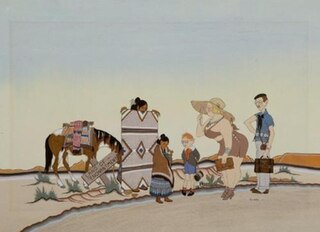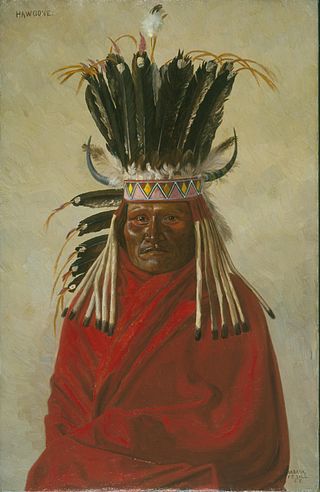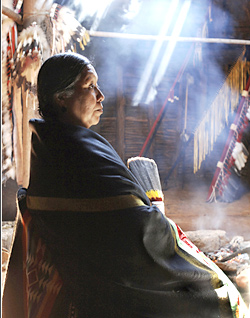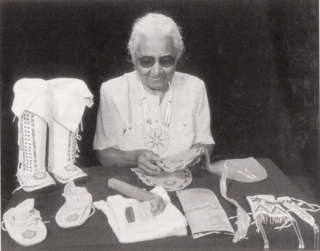
Comanche County is a county located in the U.S. state of Oklahoma. As of the 2020 census, the population was 121,125, making it the fifth-most populous county in Oklahoma. Its county seat is Lawton. The county was created in 1901 as part of Oklahoma Territory. It was named for the Comanche tribal nation.

Caddo County is a county located in the U.S. state of Oklahoma. As of the 2020 census, the population was 26,945. Its county seat is Anadarko. Created in 1901 as part of Oklahoma Territory, the county is named for the Caddo tribe who were settled here on a reservation in the 1870s. Caddo County is immediately west of the seven-county Greater Oklahoma City metro area, and although is not officially in the metro area, it has many economic ties in this region.

Anadarko is a city in Caddo County, Oklahoma, United States. The city is fifty miles (80.5 km) southwest of Oklahoma City. The population was 5,745 at the 2020 census. It is the county seat of Caddo County.

Woodrow Wilson Crumbo (Potawatomi) was an artist, Native American flute player, and dancer who lived and worked mostly in the West of the United States. A transcript of his daughter's interview shows that Mr. Crumbo was born on January 31, 1912, so there is a discrepancy of the date until confirmation. As an independent prospector in New Mexico in the late 1950s, he found one of the largest beryllium veins in the nation, valued at millions of dollars.
The Kiowa Six, previously known as the Kiowa Five, is a group of six Kiowa artists from Oklahoma in the early 20th century, working in the "Kiowa style". The artists were Spencer Asah, James Auchiah, Jack Hokeah, Stephen Mopope, Monroe Tsatoke and Lois Smoky.

Silver Horn or Haungooah (1860–1940) was a Kiowa ledger artist from Oklahoma.
Jack Hokeah was a Kiowa painter, one of the Kiowa Six, from Oklahoma.
James Auchiah (1906–1974) was a Kiowa painter and one of the Kiowa Six from Oklahoma.
Monroe Tsatoke (1904–1937) was a Kiowa painter and a member of the Kiowa Six from Oklahoma.
Stephen Mopope (1898–1974) was a Kiowa painter, dancer, and Native American flute player from Oklahoma. He was the most prolific member of the group of artists known as the Kiowa Six.
Lois Smoky Kaulaity (1907–1981) was a Kiowa beadwork artist and a painter, one of the Kiowa Six, from Oklahoma.

Vanessa Paukeigope Santos Jennings is a Kiowa/Kiowa Apache/Gila River Pima regalia maker, clothing designer, cradleboard maker, and beadwork artist from Oklahoma.
Sherman Terrance Chaddlesone was a Kiowa Indian painter from Anadarko, Oklahoma, who played a pivotal role in late 20th century Native American art.
David Emmett Williams was a Native American painter, who was Kiowa/Tonkawa/Kiowa-Apache from Oklahoma. He studied with Dick West at Bacone College and won numerous national awards for his paintings. He painted in the Flatstyle technique that was taught at Bacone from the 1940s to the 1970s.

Josephine Myers-Wapp was a Comanche weaver and educator. After completing her education at the Haskell Institute, she attended Santa Fe Indian School, studying weaving, dancing, and cultural arts. After her training, she taught arts and crafts at Chilocco Indian School before joining the faculty of the newly opened Institute of American Indian Arts in Santa Fe. She taught weaving, design, and dance at the institute, and in 1968 was one of the coordinators for a dance exhibit at the Mexican Summer Olympic Games. In 1973, she retired from teaching to focus on her own work, exhibiting throughout the Americas and in Europe and the Middle East. She has work in the permanent collection of the IAIA and has been featured at the Smithsonian Institution. Between 2014 and 2016, she was featured in an exhibition of Native American women artists at the Museum of Indian Arts and Culture in Santa Fe.

Southern Plains Indian Museum is a Native American museum located in Anadarko, Oklahoma. It was opened in 1948 under a cooperative governing effort by the United States Department of the Interior and the Oklahoma state government. The museum features cultural and artistic works from Oklahoma tribal peoples of the Southern Plains region, including the Caddo, Chiricahua Apache, Comanche, Delaware Nation, Kiowa, Plains Apache, Southern Arapaho, Southern Cheyenne, and Wichita.

Alice Littleman was a Kiowa beadwork artist and regalia maker, who during her lifetime was recognized as one of the leading Kiowa beaders and buckskin dressmakers. Her works are included in the permanent collections of the National Museum of Natural History, the National Museum of the American Indian, the Southern Plains Indian Museum, and the Oklahoma Historical Society.

Clara Williams Archilta, was a Kiowa-Apache-Tonkawa painter and beadworker from the San Ildefonso Pueblo tribe. A self-taught artist with no formal art training, Archilta is known for her watercolor painting and her pictorial beadwork.

Blockhouse on Signal Mountain is located along Mackenzie Hill Road within the West Range of the Fort Sill Military Reservation inceptively declared as Camp Wichita during May 1868 within the current administrative division of Comanche County, Oklahoma. The blockhouse was established in 1871 pursuant to the Medicine Lodge Treaty of 1867.

Beverly Horse was an educator activist for Native American and women's rights. She was an enrolled citizen of the Kiowa Indian Tribe of Oklahoma and was a government administrator for women's programs. The Oklahoma Human Rights Commission recognized her efforts to expand human rights and the Oklahoma Women's Hall of Fame inducted her in 1997.












